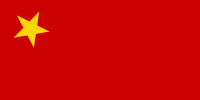Malayan Races Liberation Army
| Malayan National Liberation Army 马来亚民族解放军 Tentera Pembebasan Rakyat Malaya | |
|---|---|
| Participant in the Malayan Emergency | |
|
Flag of the MRLA. | |
| Active | 1948–1989 |
| Ideology |
Communism Maoism Marxism–Leninism |
| Leaders | Chin Peng Abdullah CD |
| Headquarters | Northern Areas of the Malayan jungle and Southern Thailand |
| Area of operations | Various areas of the Malayan jungle and Southern Thailand |
| Strength | 8,000[1][2][3][4]soldiers |
| Originated as |
Malayan People's Anti-Japanese Army Young Malays Union |
| Opponents |
United Kingdom Australia New Zealand Federation of Malaysia Federation of Rhodesia and Nyasaland Fiji |
| Battles and wars |
Malayan Emergency Communist insurgency in Malaysia (1968–89) |
The Malayan National Liberation Army (MNLA), often mistranslated as the Malayan Races Liberation Army or MRLA, was a guerrilla army based in the Malayan peninsula and Singapore. It originally fought the Japanese during the second world war as the Malayan People's Anti-Japanese Army (MPAJA), from 1948-1960 it fought British and Commonwealth forces for an independent Malaya. In 1968 the MNLA resurged operating from Southern Thailand it fought against the Malaysian government in various areas of the Malayan jungle mainly in the North. In 1989 the Malayan Communist Party signed a peace treaty with the Malaysian state and the MNLA and the Party settled in villages in southern Thailand.
Name
Malayan Races Liberation Army is a translation from the Chinese 马来亚民族解放军 where 民族 means "nationality" in the ethnic sense. The organization's leader Chin Peng has called this a mistranslation and corrected it to Malayan National Liberation Army (MNLA).[5][6] The name of the MNLA in Malay (Malay: Tentera Pembebasan Rakyat Malaya) could also be translated as the Malayan People's Liberation Army[7] although extant records show that the title Tentera Pembebasan Nasional Malaya or MNLA became the normal self-identity by the 1970s.[8]
History
The MNLA was a guerrilla force created by the Malayan Communist Party and, to some extent, led and dominated by overseas Chinese communists. It was a successor of the Malayan People's Anti-Japanese Army (MPAJA), another guerrilla force which the British had secretly trained and equipped with arms during World War II in the fight against the Japanese Occupation. The Communist Party, which had been banned in the pre-war years, was thereafter granted legal recognition by the British after the war as a reward for its wartime effort, but had secretly kept some of the MPAJA's weapons for future use.
The MCP used violence to support its union organisation, and the British used restrictions, including banishing key communist leaders not born locally, to restrict the MCP. This mutual antagonism climaxed with an armed revolt in 1948, which resulted in the declaration of the state of emergency in June 1948.
Defeated in the first Malayan emergency (1948–1960) in the Malayan jungles, and outwitted in Singapore politics by nationalist politician Lee Kuan Yew, by the mid-1960s it was fragmented.
Renewed insurgency
In 1968, the MNLA resurged, it operated out of the Thai border and carried out ambushes, hit and run attacks and planted traps. The MNLA fought in various parts of the Malayan jungle mainly in the north. The MNLA failed to resurge to the size and strength as it was during the Malayan Emergency. The MCP begun recruitment of Thai Malays as well as distributing pamphlets preching the compatibility between Islam and Communism. The MNLA had some success early on in the war killing 17 members of the security forces in a single attack. In 1989 the MCP came to the negotiating table and promised to disarm the MNLA as long as the Malaysian government would allow MCP/MNLA cadres to return home. The MCP/MNLA destroyed their weapons and settled in "peace villages" in Southern Thailand.
This allowed some of the remaining MCP members to settle in 'Peace Villages' in southern Thailand, others to return to Malaysia. No agreement was signed with Singapore, and Secretary-General Chin Peng (in office 1947-2013) has subsequently been denied the right to return to Malaysia.
References
- ↑ Malayan Emergency
- ↑ Tourism Malaysia http://www.spiritofmalaysia.co.uk/page/malaya-emergency
- ↑ Terrorism in Southeast Asia: Implications for South Asia from The New Dehli International Workshop on International Terrorism in Southeast Asia and its Likely Implications for South Asia April 2004 - Pub. Pearson Education India, 2005 ISBN 8129709988 Page203
- ↑ "The Myth Of Ethnic Conflict" by Beverly Crawford & Ronnie D. Lipshutz University of California at Berkeley 1998 ISBN 978-0877251989 Page 3
- ↑ Chin, Peng (2003), Alias Chin Peng : My Side of History : Recollections of a Revolutionary Leader, Singapore: Media Masters, ISBN 981-04-8693-6
- ↑ CC, Chin; Hack, Karl, eds. (2005), Dialogues with Chin Peng : New light on the Malayan Communist Party, Singapore: Singapore Univ. Press, ISBN 9971-69-287-2
- ↑ Abdullah, C.D (1998), Perang Anti-British dan Perdamaian, Hong Kong: Nan Dao, ISBN 962-85331-2-6
- ↑ Kenang2an Sejarah: 25 Tahun Mulia Rejimen 10 TPNM, Underground: Pejabat "KEBENARAN", 1974

